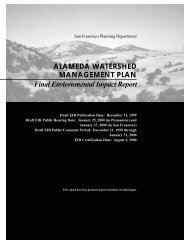Feasibility of Fish Passage at Alameda Creek Diversion Dam
Feasibility of Fish Passage at Alameda Creek Diversion Dam
Feasibility of Fish Passage at Alameda Creek Diversion Dam
You also want an ePaper? Increase the reach of your titles
YUMPU automatically turns print PDFs into web optimized ePapers that Google loves.
<strong>Feasibility</strong> <strong>of</strong> <strong>Fish</strong> <strong>Passage</strong> <strong>at</strong> <strong>Alameda</strong> <strong>Creek</strong> <strong>Diversion</strong> <strong>Dam</strong>about 18 miles <strong>of</strong> accessible salmonid habit<strong>at</strong> (MMWD, 2007). During most years, the w<strong>at</strong>ershedsupports 8 to 16 steelhead redds per mile. Redds are concentr<strong>at</strong>ed in stream reaches where substr<strong>at</strong>eand flow are favorable. Localized redd densities within favorable reaches have been observed as highas 35 redds per mile during some years. Across different w<strong>at</strong>ersheds, redd density is highly variable,depending on individual river and stream characteristics. Maahs and Gilleard (1993) report th<strong>at</strong> foreight coastal Mendocino County streams, redd (assumed to be mostly steelhead) densities in Februaryrange from much less than 1 redd per mile up to approxim<strong>at</strong>ely 5 redds per mile. Steelhead reddsurveys in the much larger, interior Fe<strong>at</strong>her River <strong>of</strong> California during 2003 indic<strong>at</strong>ed redd counts <strong>of</strong>36 per mile, with nearly all redds concentr<strong>at</strong>ed within a few miles <strong>of</strong> the river system (DWR, 2003).Based on these d<strong>at</strong>a, future steelhead redd density above ACDD is estim<strong>at</strong>ed to have a potential rangefrom 1 to 35 per mile.Given the above estim<strong>at</strong>e <strong>of</strong> between 4 and 10 miles <strong>of</strong> potentially suitable steelhead habit<strong>at</strong> aboveACDD, and the expect<strong>at</strong>ion <strong>of</strong> between 1 and 35 redds per mile, the habit<strong>at</strong> above ACDD may becapable <strong>of</strong> supporting between 4 (1 redd/mile × 4 miles <strong>of</strong> habit<strong>at</strong>) and 350 (35 redds/mile × 10 miles<strong>of</strong> habit<strong>at</strong>) steelhead redds annually, with the actual value likely lying somewhere in between. Basedon this estim<strong>at</strong>e, it may be possible for habit<strong>at</strong> above ACDD to sustain a popul<strong>at</strong>ion <strong>of</strong> steelhead (seeAppendix C). If the quantity and quality <strong>of</strong> habit<strong>at</strong> above ACDD are insufficient to independentlysustain a popul<strong>at</strong>ion <strong>of</strong> steelhead, then it is likely sufficient to sustain a subpopul<strong>at</strong>ion large enough tocontribute to a steelhead metapopul<strong>at</strong>ion in the <strong>Alameda</strong> <strong>Creek</strong> W<strong>at</strong>ershed, if subpopul<strong>at</strong>ions are alsoestablished <strong>at</strong> other loc<strong>at</strong>ions.6.3 ENVIRONMENTAL CONSIDERATIONSThis section summarizes non-steelhead environmental consider<strong>at</strong>ions including biology, wetlands,and cultural resources rel<strong>at</strong>ed to fish passage <strong>at</strong> ACDD. Construction and oper<strong>at</strong>ion <strong>of</strong> fish passagewould result in some unavoidable adverse environmental impacts. Such impacts are typical whenconstructing nearly any type <strong>of</strong> project in n<strong>at</strong>ural lands in California, and should not be consideredprohibitive, but this would certainly add to the overall cost <strong>of</strong> providing fish passage. In addition toevalu<strong>at</strong>ing the design components as in the previous sections, the environmental impacts associ<strong>at</strong>edwith construction and oper<strong>at</strong>ion <strong>of</strong> the different design components also should be considered beforeimplementing fish passage. Impacts may require permitting, minimiz<strong>at</strong>ion, and mitig<strong>at</strong>ion.While the specific impacts <strong>of</strong> fish passage as evalu<strong>at</strong>ed in this technical memorandum would beaddressed separ<strong>at</strong>ely in specific permitting documents, the types <strong>of</strong> impacts th<strong>at</strong> could potentiallyoccur could include:■■■■Interference with the movement <strong>of</strong> resident fish species;Some localized placement <strong>of</strong> fill in jurisdictional w<strong>at</strong>ers <strong>of</strong> the United St<strong>at</strong>es, including wetlands,th<strong>at</strong> are regul<strong>at</strong>ed under the federal Clean W<strong>at</strong>er Act, to construct fish passage facilities andinfrastructure;Limited loss or degrad<strong>at</strong>ion <strong>of</strong> riparian habit<strong>at</strong>s regul<strong>at</strong>ed by the CDFG under the <strong>Fish</strong> and GameCode <strong>at</strong> loc<strong>at</strong>ions where facilities are constructed; andLimited loss or degrad<strong>at</strong>ion <strong>of</strong> habit<strong>at</strong>s th<strong>at</strong> are potentially used by special st<strong>at</strong>us species(federally or st<strong>at</strong>e-listed, or st<strong>at</strong>e species <strong>of</strong> concern), including the California red-legged frog, thefoothill yellow-legged frog, the California tiger salamander, and <strong>at</strong> least one species <strong>of</strong> b<strong>at</strong> <strong>at</strong>loc<strong>at</strong>ions where facilities are constructed or roadwork is required.ACDD <strong>Passage</strong> June 2009 Page 6-6








